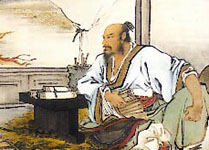AAS 2007
War and Peace in Early China
Moderator: E Bruce Brooks, University of Massachusetts at Amherst
AAS Convention, Boston, Saturday 24 March 2007
Click on a title to see the speaker's text or abstract
The Wars of Wu and Ywe
The modern picture of the early coastal states Wu and Ywe consists in large part of vignettes from their mutual warfare of extermination, which make up some of the more memorable pages of the Jan-gwo Tsv and the Shr Ji. If we move beyond these sensationalistic accounts, do we get a more balanced picture? We must begin by asking what we can reliably know about the early history of Wu and Ywe, and how that history evolved into myth over time. The following papers focus on some of the problems with the sources for the history and culture of Wu and Ywe.
E Bruce Brooks
University of Massachusetts at Amherst
The Bamboo Annals and the History of YweEric Henry
University of North Carolina at Chapel Hill
The Ywe Jywe ShuStephen Durrant
University of Oregon
The Wu/Ywe Chun/Chyou*Steve is prevented by schedule constraints from delivering his paper as planned. His abstract is retained as a suggestion for open discussion by those attending the panel.
The Micians and War
The school of Mwodz originally opposed war as a quirk of the ruling class, but ruinous to the livelihood of ordinary citizens. That position was later modified, and the Micians themselves went into the war business, albeit on the defensive side. This put them in opposition, not to the warmaking elite, but to the ultimately successful unification process. The following papers focus on different aspects of that long evolution, from texts in different parts of the huge Mician corpus.
Don Wyatt
Middlebury College
The Philosophy of Peace (MZ 17-19)A Taeko Brooks
University of Massachusetts at Amherst
The Impact of Defense (MZ 51-71); full text is also availableAll papers and abstracts posted on this site are Copyright © by their authors.
17 Feb 2007 / Contact The Project / Exit to Conferences Page
